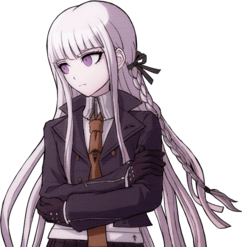Video Game review: Danganronpa: Trigger Happy Havoc
- Cade.M
- Jun 12, 2019
- 5 min read
Updated: Sep 6, 2019
Danganronpa Trigger Happy Havoc is a Japanese visual novel game with anime graphics that revolves around murder and mystery on the PS Vita, PC and (exclusively in Japan) PSP developed by Spike Chunsoft. Well known for games such as Dragon Quest, Zero Escape and Steins;Gate. Danganronpa revolves around the themes of hope, despair and mystery. In addition, Trigger Happy Havoc is the first instalment for the Danganronpa franchise.

In this review, I will be going over the main elements of the game: - Story - Characters - Graphics - Gameplay - Replay-ability - Design - Difficulty - Sound
Furthermore, I am going to be rating from a scale out of 1-10
Story/Synopsis: Now before I get into the story, Danganronpa is (in my opinion) quite the obstacle to talk about without avoiding spoilers. With that being said, I will try my best to avoid going into too much detail.
You are the protagonist; Makoto Naegi who is the ultimate ‘lucky’ student. On a whim he was invited to Hope Peaks Academy to become a student. When he sets foot into the school building he collapses and wakes up inside a class. Little did he know what he was getting into; a death game alongside 14 other students led by the bear himself: Monokuma. Monokuma is the main antagonist. In order to beat Monokuma’s game, a student has to murder someone and not get caught in order to escape.. If that student has been founded to be the suspect however they will be executed. Whereas if they don’t catch the suspect. Not only does the suspect get to escape but the remaining students all get executed from the game. Meaning the game itself finishes.
The story structure applies like this for every chapter: Character and story dialogues > free time > build up > investigation > trial > climax for the chapter. You investigate murders, pursue and find clues and negotiate with your classmates in preparation for the trial. Engaging in wordplay, going every corner and inch of evidence to vote for the suspect. Dissecting their statements and exposing their lies. Thankfully this game has about 6 chapters in total so it doesn’t stray in to being a dry formula. In fact, each chapter has its own theme and personality to it which could be considered to be its saving grace. Danganronpa has it’s plot twists, tensions, suspenses and climaxes in the story itself. Tension and suspense is built around the investigation. Crafting in climaxes and to some extent, plot twists.
I personally liked the execution (no pun intended) of Danganronpa’s climaxes and trials. They were well crafted and many factors are considered. Which then brings me onto the gameplay.
Characters: Danganronpa’s main cast consists of 15 students (which later on goes to 16 students) and a bear called: Monokuma for Hope’s Peak Academy’s Class 78th. When I was playing Danganronpa I felt that some characters were set up as victims and to give certain characters development. Danganronpa’s cast had variable personalities going for it. You had Makoto Naegi who is an average high schooler who is considered to be the “Ultimate Lucky”. Sayaka Maizono who is Makoto’s friend and the “Ultimate School Idol”. Personally my favorite characters in Danganronpa are Kyouko Kirigiri, Byakuya Togami and Monokuma.
Left to right. Kyouko Kirigiri, Byakuya Togami and Monokuma.
Gameplay: Danganronpa’s gameplay is linear and varied. (Especially during the trial aspect of the game) and the camera is in first person perspective. The difficulty modes in Danganronpa are:
· Gentle
· Kind
· Brutal
Danganronpa tends to be at most, very linear. There are two different aspects of gameplay within Danganronpa. The School Life aspect and the Trials aspect.
School life: You are isolated from the world within the school so you can only do things in the school life such as talk to your friends, interact with objects and findings. To put the school life into other words, it’s essentially a school simulation which makes most of the visual novels. You can interact in dialogues when purple text appears. Open and close the maps of the school or interaction circles. Grow bonds with your classmates etc.
During the school life, you’ll be spending 1/3rd of the time in game by doing investigations. Searching for clues. Pinning down the victims and witnesses by speaking to them on their account or what they’ve found.
Trials: In Trials there are 3 core mini game elements. Hangman’s Gambit, Tempo and Deadly Wordplay.
Hangman’s Gambit is where you find the missing letters for a keyword that revolves into the incidents for the class trial.
Tempo (aka M.T.B) is similar to rhythm based games. You hit the the circles at the right time and put a crosshair target onto the words. In effect, this’ll deplete the targets hearts each time when the words are shot. Your opponent has 10 hearts and the player has 5 hearts. Depending on the difficulty of the game there are certain elements that can’t be played on gentle mode.
Deadly Wordplay is depicting words from people’s lies and reinforces their statements by proving people wrong. From the gameplay perspective, Deadly Wordplay is done in 2 bullets. The truth bullet (aka verbal bullets) in which you shoot their lies. The absorb bullet is where you take a word from people’s mouths and from there shoot it with that lie.
Moving onto the design and graphics.
Graphics/Design: Danganronpa has a stylish, edgy, surreal and dark design, underlying itself with anime like characteristic designs. The graphics tend to have the designs (from a gameplay perspective) as cardboard cutouts for the characters and props.
The stylish part of the graphics often occurs from the trials. For example, the manga (Japanese comics) in my opinion is stylish. The dark tones usually lie under the sound design and atmosphere.
Sound: I will be going over 3 sound factors. 1. Soundtrack 2. Voice overs 3. Sound effects
Soundtrack: Danganronpa’s Soundtrack’s incoporates other styles of music the music genres. It isn’t really just one genre. There’s electronic, jazz and techno etc. I personally love the variety and complex rhythm that plays in the soundtrack. In fact, I would put the games soundtrack in my top 20 game soundtracks of all time. My favorite soundtracks from the game:
BOX 15
Mr Monokuma's Lesson https://www.youtube.com/watch?v=ELfxtdEakhk
Discussion -Hope vs Despair- https://www.youtube.com/watch?v=zpPnEwZiDno
Voice acting: I played Danganronpa in English Audio but there are options for the Japanese audio for the game too. Personally I enjoyed the voice cast. Creating personality, voice and tones for each character. The majority of the main voice actors voiced one member of the main cast.
Sound effects: The sound effect frequently occur from the character or come off as a shock factor or to surprise. It could create tension, an empathises on the character’s mood or creates a sense of danger around the characters themselves.
Overall I love the use of sounds in Danganronpa. They are well done and whilst the Danganronpa’s English voice actors from the characters perspective aren’t speaking in the native language. I personally thought they did a decent job as is.
Personal thoughts: Having gotten myself into the Danganronpa franchise as of late, I'll admit it was very fun, intense, exciting and thrilling to play. The murder mystery aspects we're always fun and would put you on the edge of your seat. Although if you were to go a head and replay Danganronpa I think the replayability isn't bad but its not great either. Post game you have a mode called School Mode. I personally haven't played it myself but it looks interesting and cool. What I enjoyed the most however was the presentation, characters and music in Danganronpa 1. I like a lot of the characters, music was phenominal stuff loved the variation of beats and multiple music genres and the presentations on design and style were excellent. Rating: Personally I would give Danganronpa 1 an 8.5/10!


























Comments